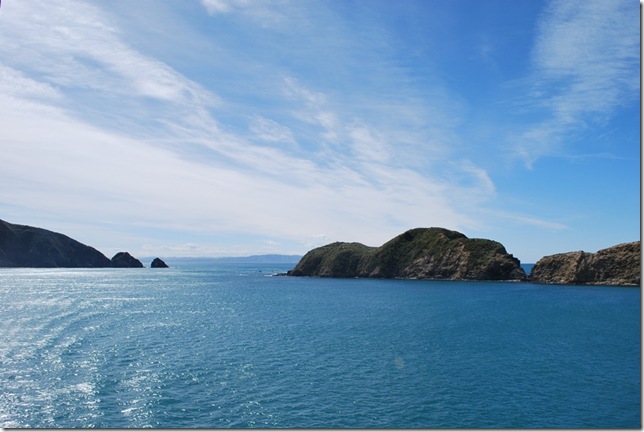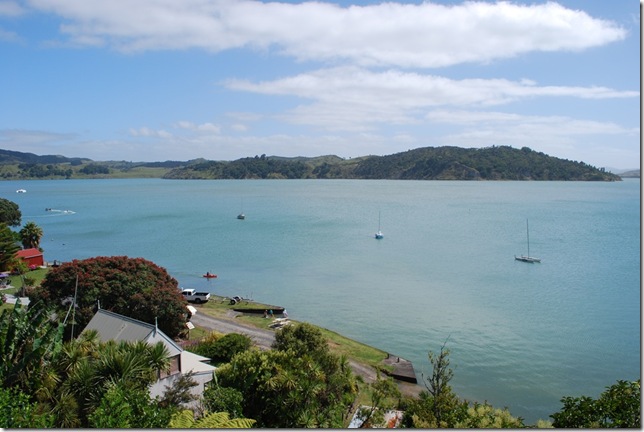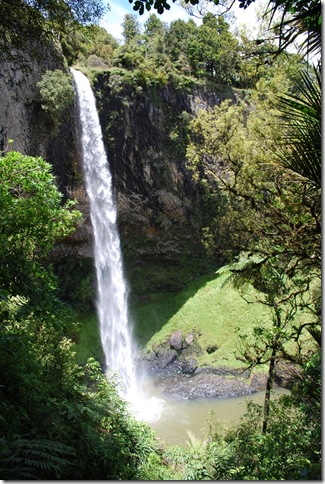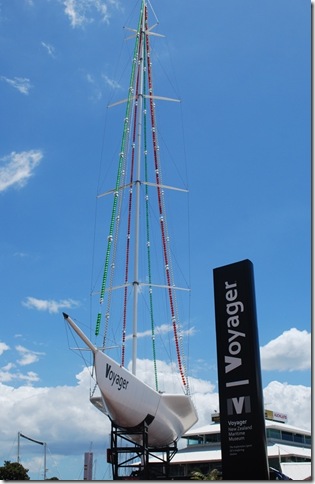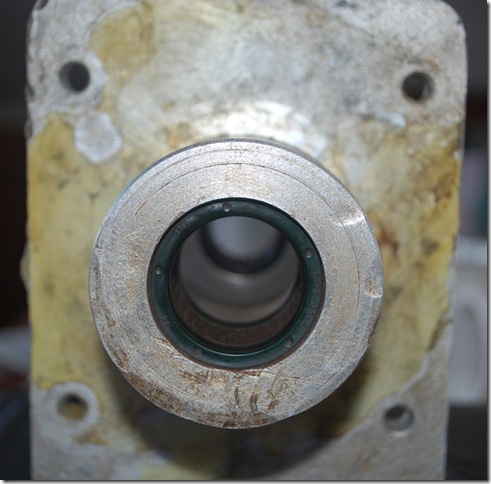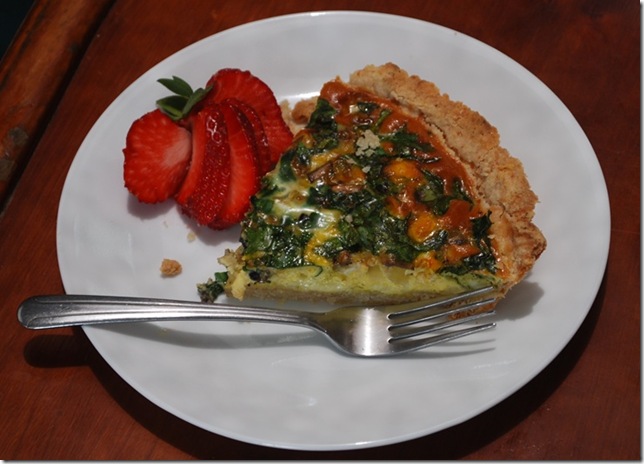We have covered a lot of ground since our last blog, which is why we haven’t had a chance to post a new one in several days. I will try to give a brief rundown of our activities.
Before leaving Tauranga, we moved the boat to the slipway without any trouble. After seeing a couple of boats smack pilings on their way in and out of their berths as a result of intense tidal current, Dallas suggested that we move at slack tide, which seemed to have made a world of difference. We easily motored out and across the harbor where we were met by Hutchison (the boat-builder) and the riggers, who assisted Dallas in taking down the forestay. It will be so nice to have a couple of major repairs completed upon our return.
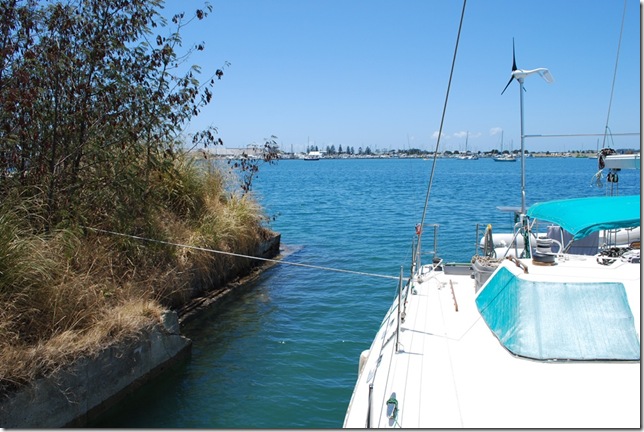 Tied up to a tree in the slipway
Tied up to a tree in the slipway
We left the boatyard at 2:00 p.m. and drove for four hours (plus a quick stop for an oil change) along the “Thermal Explorer Highway” to Napier. Along the way, we saw what looked like a nuclear stack, but it was a large geothermal power plant where the heat from seismic activity is being converted to usable energy. Napier is a colonial city on the east coast that was nearly destroyed in an earthquake in the 1930’s. It was rebuilt in the “art deco” style and is now known for this as well as its vineyards. We went out for yummy Thai food and returned to the colonial-style B&B where we were staying for a glass of locally-produced Sauvignon Blanc on the veranda before calling it a day. The next morning, our hosts fixed us a traditional English breakfast (muesli, thick sausages, baked tomato, eggs), and we were on our way. We decided it was a bit too early to be tasting wine, so we bypassed the wineries and headed on to Wellington at the southern tip of the North Island.
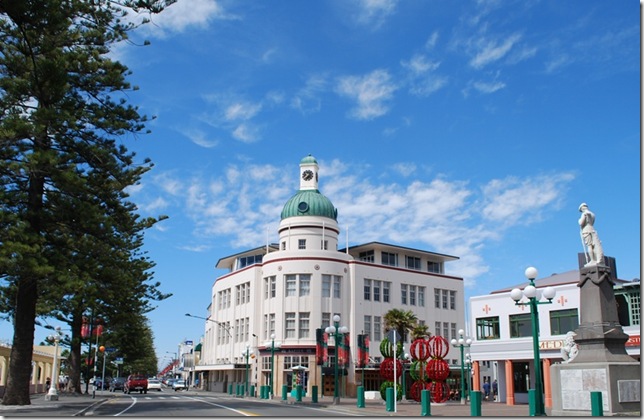 The “Art Deco” style of Napier
The “Art Deco” style of Napier
We arrived in the capital city in late afternoon and headed straight for the cable car ride. This was my suggestion, as we only had one night to spend there and wanted to get a feel for the city. As it turned out, the entire ride lasted maybe 5 minutes, so that was comical. Fortunately the last stop offered a nice view of the city, and the scenic walk back through the botanical gardens was lovely despite the chill from the winds coming down off the mountains. We had another bit of good fortune in that Te Papa, the national museum of NZ, was open late (only on Thursdays!), so we had a chance to see impressive exhibits such as the colossal squid that was accidentally caught on a hook by a fishing boat in the Southern Ocean. We also read the somewhat discrepant English and Maori versions of the Treaty of Waitangi in which the Maori chiefs granted the English the authority to rule NZ in exchange for land rights. The video demonstrations of the rituals of carving pounamu (jade) and making tapa cloth out of mulberry bark also were fascinating. It was an awesome museum and capped off another full day!
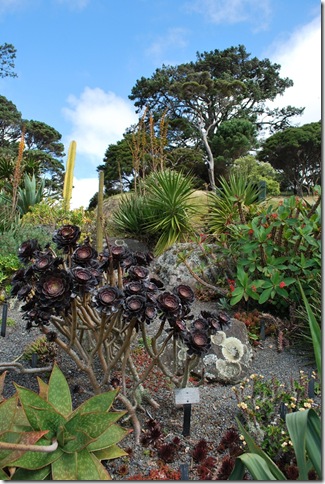 The “succulents” at the Wellington Botanic Garden
The “succulents” at the Wellington Botanic Garden
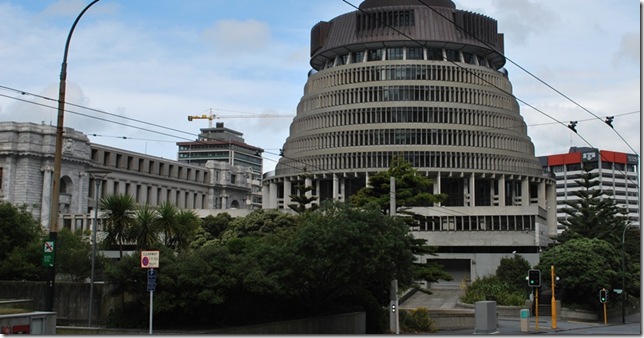 The “Beehive”, home of the NZ Parliament
The “Beehive”, home of the NZ Parliament
Our Wellington accommodations left some things to be desired (soap, for example!), but we weren’t there long, as we had to get on the ferry by 7:30 a.m. The inter-island ferry boat was massive and replete with recliners (we found these right away), two movie theaters, and a magic show for the kids (and me). The Cook Strait was about as calm as it could be, especially considering the gale warning that had been in place just 12 hours prior. My mom is very sensitive to motion but had no problems, and we all enjoyed the views from the bow as we approached Marlborough Sounds.
Once on the South Island, we drove south for 4.5 hours to Christchurch. The Marlborough region is regarded as the best in NZ in terms of its wines, so after lunch we stopped off at the Montana Winery—their wine is sold in the U.S. by a different name since the state name was expected to be a turn off to the American consumer. The four of us agreed that their whites were better than their reds. Anyway, we arrived in Christchurch, the largest city in the South, in early evening and dined at a Mexican restaurant (a Richerson favorite). The restaurant and the city center in general were quite hip, seeming to cater to the University of Canterbury crowd. The next morning we went back to the city center to check out the local markets and the local museum. Though the architecture and style of the area are clearly colonial, the local artisans seemed to peddle Maori designs such as pounamu jewelry and carved wooden masks. While walking to the museum, we heard music coming from the Arts Center and popped in to discover a group of local Maoris dressed in native garb and performing traditional songs. Dallas and I had seen a very similar performance while in the Cook Islands but were really pleased that my parents were able to see it for themselves. And we were really impressed by yet another museum. The highlight for me was the excellent photography exhibit, while Dallas was naturally drawn to the stories of the original Antarctic explorers (e.g., Shackleton).
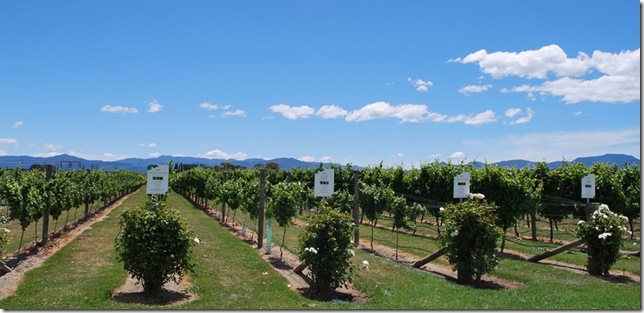 The orchards of Montana Vineyard
The orchards of Montana Vineyard
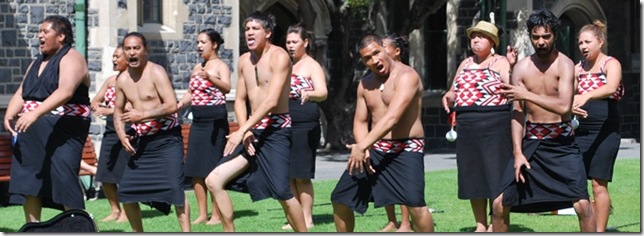 Performing the traditional “Haka” (warrior chant)
Performing the traditional “Haka” (warrior chant)
From Christchurch, it was back on the road for a 7-hour drive to Queenstown where we did in fact get a bit of rest…not too much, though! Stay tuned for more on our whirlwind tour of the South Island.
It has been so nice to see my parents after being separated by many miles for 10 months. I am loving every minute of their visit, and Dallas seems to be enjoying his time with the “in-laws” as well. In addition to regaling them with stories of our adventures and showing them all of our souvenirs, we are making new memories by visiting some of the sites of the North Island. We hit the ground running after picking them up from the airport in Auckland. They managed to sleep on the plane and had enough adrenaline to keep them going all day! The clouds burned off in time to have a nice view of the city from One Tree Hill. Then it was on to Viaduct Harbor where we dined at the Irish pub and checked out the diverse boats, from the old flat-bottomed scows to the gargantuan $700/day cruise ship. The 200 km drive to Tauranga was very scenic, and my parents were quite impressed with the variety of foliage, particularly the ever-present NZ fern.
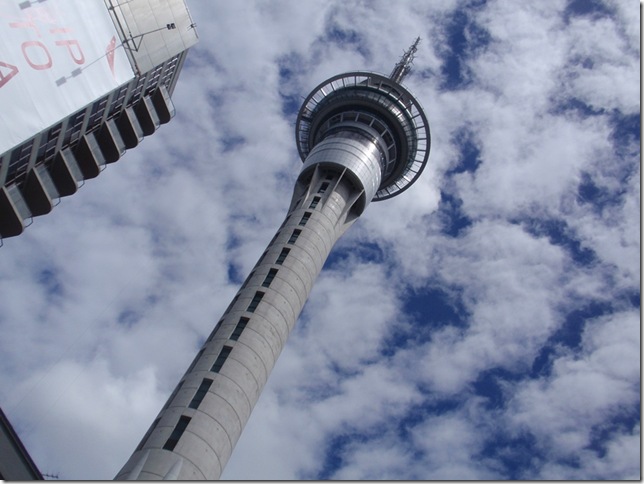 Mom’s pic of the Auckland Sky Tower
Mom’s pic of the Auckland Sky Tower
Monday we took it easy in the morning but headed off for some sight-seeing in nearby Rotorua around midday. We stopped at the infamous fresh fish (pronounced “fush” in Kiwi) ‘n chips shop here in Tauranga, right along the harbor where the fishing boats unload. The hogi fish was as fresh and tender as any of us had ever had. We enjoyed watching the local kids fishing for hogi but reeling in seaweed.
Our next stop was a crowd-pleaser as well. Dallas and I had passed the enormous kiwi advertising the Kiwi 360 exhibit several times but did not expect it to be so interesting. We toured the orchards that were used to grow 65 varieties of fruit as well as much of the kiwi that you might buy in the store back in the U.S. Apparently the conditions here in the Bay of Plenty (i.e., the volcanic ash in the ground, the occasionally freezing temps, and plenty of sun and rain) are ideal for growing kiwi, which I now believe is the healthiest of fruits (more vitamin C than an orange, more potassium than a banana). After the tour, we had the opportunity to taste the green (what we are used to) and gold varieties of kiwi as well as some kiwi wine and liqueur.
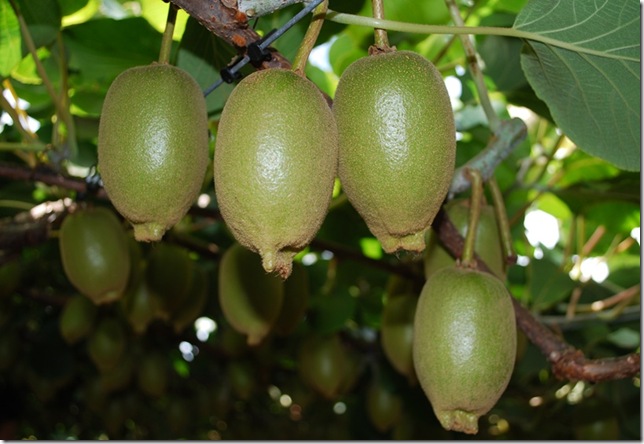 The unique gold variety was less sweet but hairless
The unique gold variety was less sweet but hairless
Rotorua is the 2nd biggest site for tourism in NZ (2nd to Queenstown), and we can appreciate why. There was something to do everywhere we looked, but we arrived late in the day, so we opted for the Museum of Art and History since it was open late. This area is the site where the first Maori settlers made their homes around 800 A.D., taking advantage of the warm ground water created by geothermal activity. They capitalized on the European tourists’ interest in the Pink Terraces there, considered to be the 8th Wonder of the World until it (along with two Maori villages) was destroyed by eruption of Mount Tarawera in 1886. European settlers later built up the city of Rotorua on top of the crater that remained, and interest in the hot baths (considered to be healing) created by piping in the warm (but stinky and sulphorous) ground water brought wealthy tourists and patients of various ailments from all over Europe.
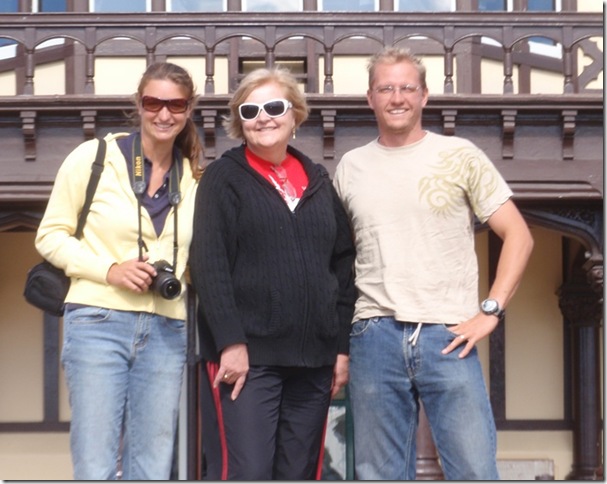 Having a great time as tourists!
Having a great time as tourists!
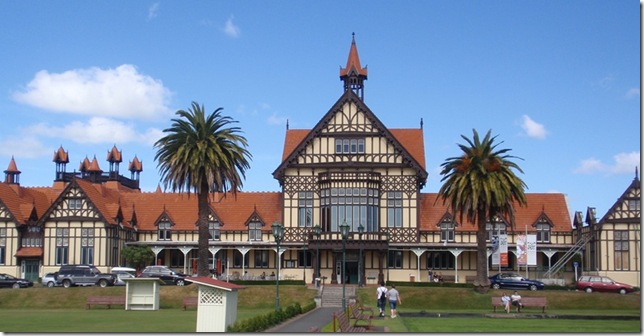 The former Bath House is now the site of the Rotorua Museum
The former Bath House is now the site of the Rotorua Museum
Tuesday we took a break from learning about the area but certainly enjoyed the natural beauty as we hiked to the top of nearby Mount Mauao. It was a gorgeous, sunny day, just perfect for viewing the beaches of Tauranga from above. It is a fairly steep climb, though, so our gelato afterward was well deserved!
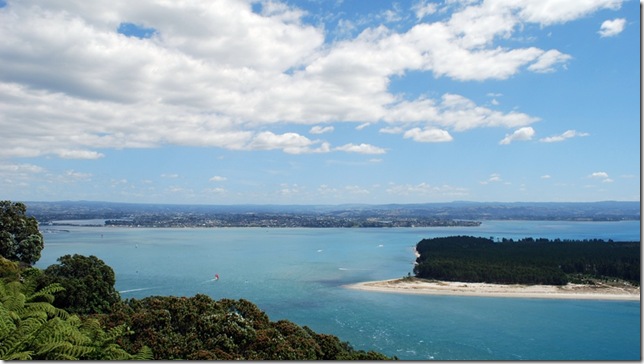 There were beautiful views all the way up the mountain
There were beautiful views all the way up the mountain
I should mention that Dallas and Dad have been doing some boat work (naturally). They took all four of our primary sails to the sailmaker for repairs, and Dad just took Dallas up the stick so that he could run some halyards that will be used to support the mast while the forestay is taken down and made to be adjustable. Dad will be ready for a vacation from his vacation when he gets home!
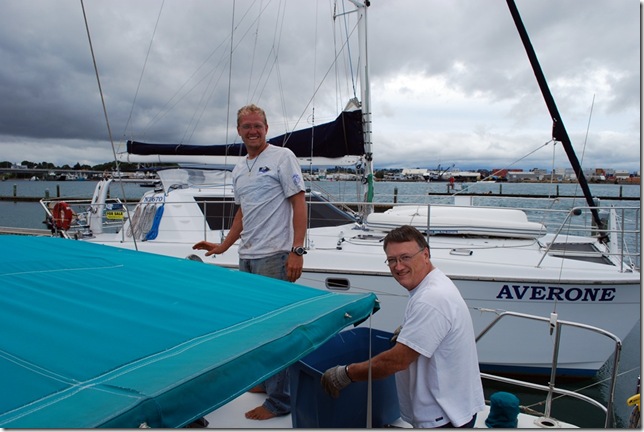 Getting the anchor chain out and ready to be re-galvanized
Getting the anchor chain out and ready to be re-galvanized
Today we are preparing to move the boat to the boatyard on the other side of the harbor so that her bow can be repaired while we are traveling around the South Island. We are headed to wine country in the Napier area later today and will continue south to Wellington tomorrow be ready to catch the ferry to the South Island on the morning of the 8th. Can’t wait!
Although we have been missing our families during the holiday season, we’ve been lucky to enjoy some great experiences here in New Zealand. After Christmas in Auckland, we spent a few days back in Tauranga doing some small boat projects and getting ready for Lauren’s parents to visit before heading off to bring in the new year with friends in Raglan.
We also had a mechanic stop by the boat to have a quick look at the port engine. Hopefully he’ll be able to make sure things are in order while the boat is at the yard and we’re out visiting the south island. There are basically three problems we’re working on. The first is that the low oil pressure alarm has been going off since the Galapagos. I assumed it was the oil pressure regulator because we’d just had to replace it in Panama, but it may be the sensor. So far, after going off consistently all across the Pacific, it has refused to act up with an oil pressure gauge on it here in New Zealand. I bought one and have it installed now, so we can see exactly what’s going on next time the alarm goes off. The second problem is that the engine seemed to get hard to start and lose power (0.5-1.0 knots slower than the starboard engine at 2400 rpms) at about the same time on the way down from Tonga. That seemed a bit odd as it was just rebuilt before leaving Florida, but luckily the mechanic didn’t think it is a compression issue. We’ll take a look at the fuel pump/injection system to make sure things are OK there. While we were troubleshooting the oil pressure problem in Opua, we noticed that the transmission was having a little trouble going into gear. It sounds like that’s going to require taking the transmission apart to have a look, but at least the timing is good — we’re near a mechanic and not planning to do any travelling with the boat for a couple of months. It seem like we’re on track to have all of our major repairs completed by the end of January, which would be nice. The last project before leaving for Raglan was to put a new zinc on the starboard prop shaft. When we were out troubleshooting the port engine a few days ago I noticed it had gone missing. A cold dip in the murky marina water wasn’t high on my list of fun things to do in the morning, but I didn’t have any intimate jellyfish encounters and it’s done.
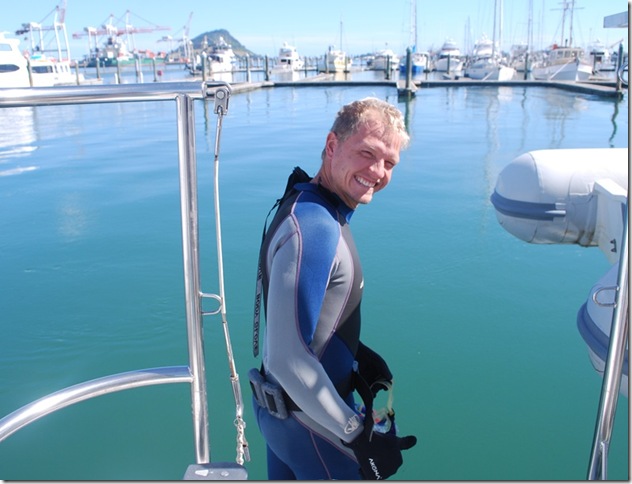 This expression means I failed at talking Lauren into jumping in and installing the new zinc
This expression means I failed at talking Lauren into jumping in and installing the new zinc
For New Year’s Eve, we headed to Raglan, a small town on the west coast of the North Island that is famous for its left-handed surfing waves. Although we had several boards at our disposal, the winds were a little too strong for the surfing to be good so we only had a quick peek at the famous waves while drving through town. Antoine, who we met in Niue when he was crewing on a sailboat and then saw again in Tonga, is living there for a while and invited us and several other cruisers and friends over to celebrate. Antoine is younger than us, but he’s now the “father” of a house with a great view overlooking the water and rugged countryside. We had a pretty international crew that included people from New Zealand, the US, Germany, Sweden, France, Canada, and the Czech Republic. Leo from Disa and the Avel Mad crew were there as well as Ash, a great Kiwi guy we met in Tonga as he was preparing for his first passage on a Moorings delivery to New Zealand. In addition to making some new friends and having a great New Years, we enjoyed a couple of the most relaxed and enjoyable days we’ve had in a long time, which is saying something for us. The people you meet while travelling really make the trip so much more enjoyable than it would be if you were just checking off the list of local tourist attractions. Most of the others were travellers as well, although Antoine is staying put long enough to work and earn some money. We stopped by the fish & chips place where he’s working to get some ice cream (ice cream is even bigger here than in the states) and remind ourselves what it looks like to work and earn some money. We all got a kick out of it, especially since he was working hard on a busy New Year’s Day with only an hour or so of sleep in a noisy house full of people.
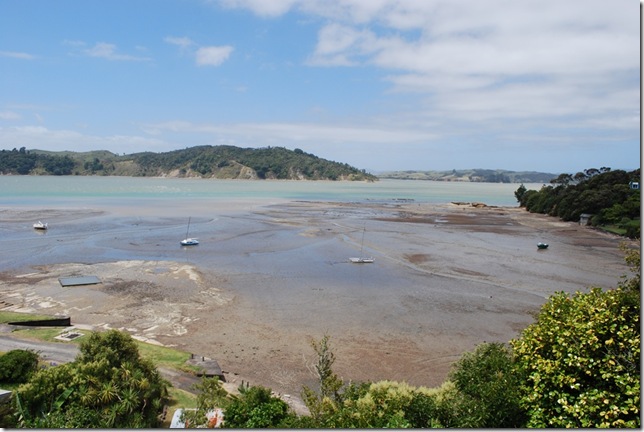 The view from Antoine’s place at low tide (the square at the left is a Kiwi tide/sun pool)
The view from Antoine’s place at low tide (the square at the left is a Kiwi tide/sun pool)
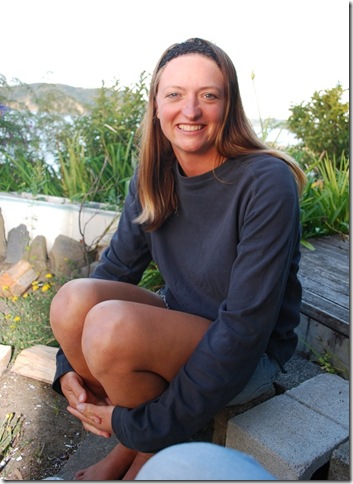 Lauren looking beautiful in her New Year’s formal wear
Lauren looking beautiful in her New Year’s formal wear
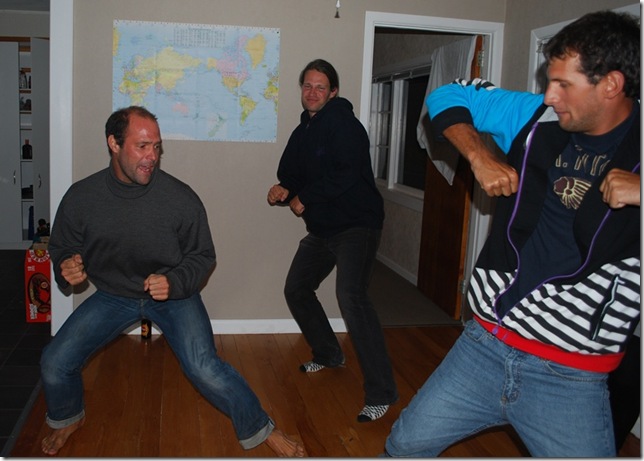 House father Antoine (left) is always in the center of things when the dancing becomes inspired and innovative
House father Antoine (left) is always in the center of things when the dancing becomes inspired and innovative
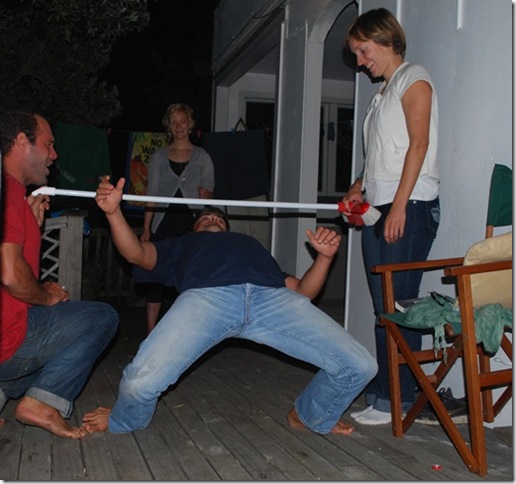 Add limbo champ to Leo’s continually expanding list of talents
Add limbo champ to Leo’s continually expanding list of talents
We’re picking Lauren’s parents up in the morning at the airport here in Auckland, which is pretty exciting, especially for Lauren. On the way here we stopped at Bridal Veil Falls which is a short drive from Raglan. The walk to the falls was short, which was a little disappointing as it’s always pleasant to spend some time hiking here, but the waterfall was impressive. It’s about 180 ft high and you’re able to see it from the top and bottom thanks to a nice set of stairs. It turns out most of the people from the Antoine’s house had the same idea. By chance, we all arrived about the same time, so we said our goodbyes after seeing the waterfall. Hopefully we’ll see some of them again at some point while we’re here.
Christmas in summer certainly is a unique experience. The holiday itself is celebrated much like in the U.S. in the sense that it is a time to enjoy family, give to others, go to church, and of course, eat as much as you possibly can, but some things are inevitably different than in the northern hemisphere as a result of the summer climate. Instead of a White Christmas, Kiwis might hope for “sweet as” conditions for surfing and boating. Rather than roasting a ham and drinking egg nog, they opt to throw some steaks and shish kebobs on the “barbie” and drink some nice, cold Tui or Steinlager beer. Apparently the Kiwi kids still believe that Santa delivers presents on his flying sleigh, but it’s hard to imagine that he would wear a furry, red suit when the temperature is approaching 80 degrees!
Dallas and I had a Merry Kiwi Christmas with the help of our friend Mel and her family in the Auckland area. They welcomed us as their guests and treated us to an awesome meal. We were able to eat outside on their veranda thanks to the shade of the umbrella. Our hosts agreed that the sun is particularly blazing here, more so than in nearby Australia. Young children are required to wear hats here when playing outdoors at school.
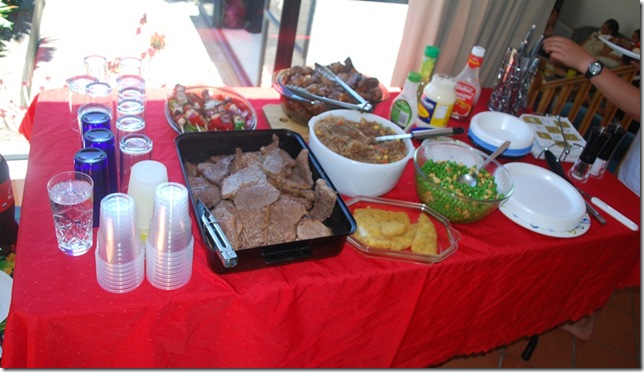 One of two food tables at the summer Christmas lunch
One of two food tables at the summer Christmas lunch
We talked more with Mel about the mix of cultures that are prevalent within NZ. She indicated that while Kiwis are totally Westernized, a minority still participate fully in Maori traditions such as meeting at the maraes and speaking the Maori language. Many other modern Maori are raised as though they were “pakeha” (descended from white Europeans). However, it seems that traditional Maori funerals have stood the test of time and European influence among many families of Maori heritage. In Mel’s family and presumably many others, it is customary for the deceased person to be brought back to his/her home for three days, during which time the immediate and extended family members sleep in the same room and say their good-byes.
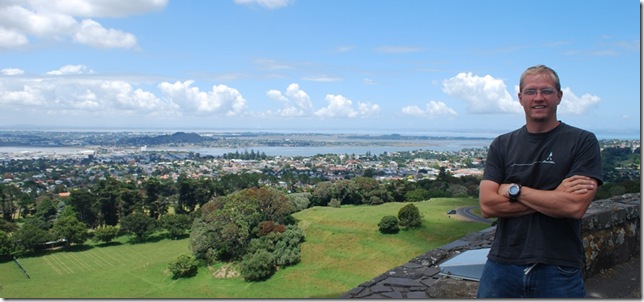 A beautiful day at Cornwall Park in Auckland
A beautiful day at Cornwall Park in Auckland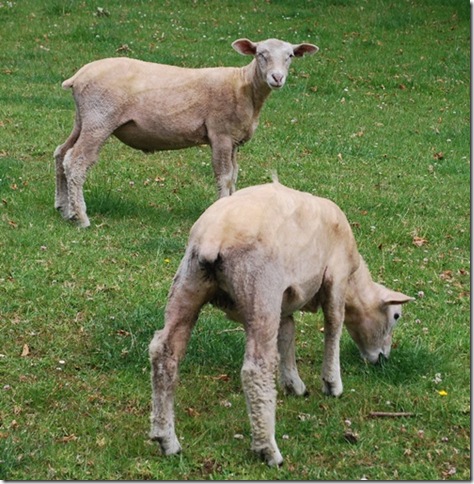 Sheared sheep mowing the park’s grass
Sheared sheep mowing the park’s grass
Also while in Auckland, we spent an afternoon in the New Zealand National Maritime Museum. Unlike Maori traditions, the culture of the sea has always been well represented in these islands, from the early Polynesian navigators who found their way here using the stars, to the European explorers/whalers that eventually immigrated, to the present day fishing charters and sailing regattas that have become national past times. The exhibits displayed each of these eras and included full-size replicas of ancient Polynesian canoes as well as smaller replicas of the last of the tall ships (masts reaching over 150′!) to be sailed around the dreaded Cape Horn as part of the Australian grain trade. The video footage of the hurricane winds encountered by such a ship in the late 1940’s as well as the crew’s configuration along the yards of the mast (horizontal spars far above deck) to set/stow the sails, helped to tell their tales of adventure.
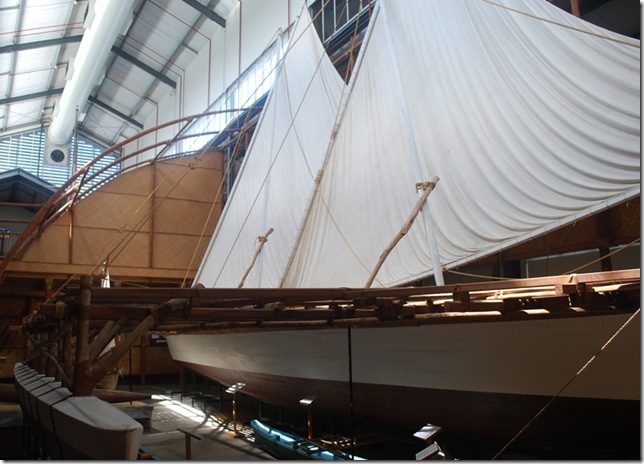 The outrigger of the canoe belongs on the windward side
The outrigger of the canoe belongs on the windward side
This Kiwi “Big Boat” was no match for the American’s catamaran in the controversial America’s Cup of 1988
There also was a special exhibit to honor the deceased Sir Peter Blake, a national hero. Peter’s crews won multiple round-the-world races, including a non-stop, 74-day voyage aboard Enza, a catamaran that averaged 16 knots! Video footage of Enza’s journey depicted crewmembers dodging icebergs in the high latitudes (60’s) and trying to hang on to the stern in 70-knot winds while deploying a drogue. In addition to these amazing feats, Peter also led an NZ crew to victory in the 1995 and 2000 America’s Cup regattas and led expeditions to Antarctica and the Amazon. He later founded an organization dedicated to environmental preservation in the Amazon, where he was ultimately killed from behind by thieves after going below deck to retrieve his gun. A pretty eventful life, I would say.
Our lives are not nearly so eventful at the moment, but we are looking forward to having some Kiwi-style adventures following my parents’ arrival in early January. They have planned an ambitious itinerary of exploration, particularly around the South Island. It should be an unforgettable trip that we will be sure to share with you.
In the meantime, I am pleased to share that Dallas penned a feature article for the January issue of SAIL magazine, which is now in newsstands! It is SAIL’s annual multihull edition, and Dallas’ article documents the ins-and-outs of buying, refitting, and cruising in an older catamaran. Check it out!
It’s been a while since we posted our last blog, and our activities since then pretty much fall into 3 categories: working on the boat, hanging out with Martin, and exploring the area a bit.
Working on the boat has taken up the most time. The Christmas holiday comes during summer here, so combined with the generally more generous holiday/vacation time here, there are a lot of small businesses that are shut down for 2-3 weeks at the end of December and beginning of January. For us, that means that our sails have to wait until January for the sail maker to start the minor repairs that several of them need. We’re also waiting for the end of the holidays to do some rigging work where the local rigger could be helpful. In the meantime, we’ve done a number of smaller jobs — completely disassembling and servicing the steering system, cleaning, making a new port head floor to replace the water-damaged one, re-finishing the cockpit table, servicing the outboard, etc. The steering system was pretty painful to remove at every step, but once it was finally done, I found that the needle bearings (little stainless rolling-pin type bearings that the wheel shaft turns on) were rusted solid and probably had been for a while. A new steering assembly is pretty expensive, but the manager of the boatyard here sent us to a local engineering shop that had replacement bearings and seals in from Auckland for us the next day for only about $30. In general, doing boat work in Tauranga has been like that. There are lots of marine and general industrial shops within a five minute drive that provide every imaginable service. People are incredibly friendly and helpful, and anything that isn’t in stock here can generally be brought in from Auckland by the next morning. It’s pretty amazing even for a first-world country.
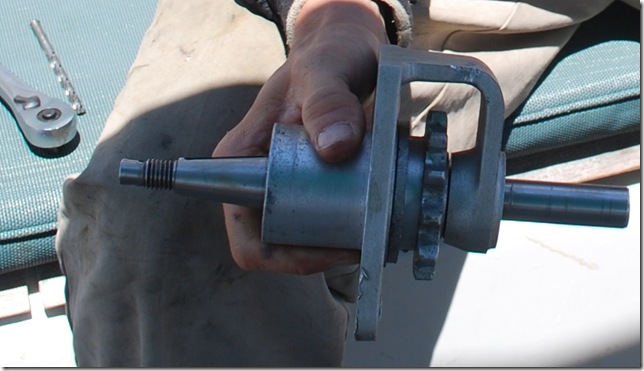 Completed steering assembly ready for installation after two long days of work
Completed steering assembly ready for installation after two long days of work
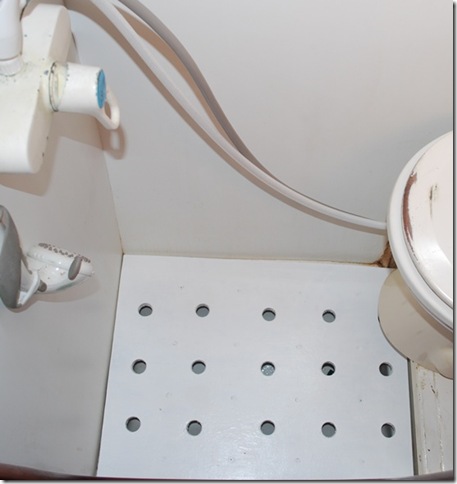 Don’t you think it makes the head look oh so roomy?
Don’t you think it makes the head look oh so roomy?
The bad news on the repair front is that when I started to repair the damage to the trampoline fittings, I noticed that things are quite a bit more serious than I thought. Most of the 6 mm stainless bolts were sheared off when our hull-to-deck joint worked loose on the inboard side of the starboard trampoline. Production boats like ours are built using a hull mold and deck mold. Once the interior of the boat is built up inside the hull, the large deck piece is fitted over it like a clam shell, and the two are bonded together around the edge. This is obviously a pretty critical structural part of the boat, and like most parts of our boat, it’s generally pretty strong. The exception seems to be this area of the bow, where there was some sort of bonding material between the hull and deck that has deteriorated and disappeared, and inside there’s only a layer or two of fiberglass that has also broken away. Pushing the boat too hard on the way from Tonga didn’t help things either. Luckily, there’s a boat builder directly across from us on the other side of the river, and we had a nice chat with the guy who runs it. He should be over on Monday to have a look and will be able to make the necessary repairs. It will probably be a bit pricey, especially since they can only haul out catamarans by renting a crane or using the railway, but it sounds like they do good work, and their labor rate is pretty reasonable (just over $35 US/hr) for this type of work. It’s another repair that will have to wait until after the holidays, so it should be a busy summer.
Martin’s been a lot of fun. At some point we discovered that we both love playing basketball, and he actually found a league here in Tauranga. They’re now between seasons, so we’ve had to settle for shooting around a bit, but tomorrow we get to play in a scrimmage, and we’ve gotten some pretty good exercise as well. He’s a great shooter, and is a physical education teacher in back home in Austria, so his fundamentals are pretty good as well. Anyone who’s actually been coached can pretty much run circles around me, but given my height and age advantage I’m able to stay competitive.
The more we explore, the happier we are that we’re in Tauranga. In addition to the nearby marine and industrial shops, there are two nice restaurant/nightlife/shopping districts. The one at Maunganui is a major vacation spot for Kiwis, with beach as far as you can see in both directions and plenty of wind for kite and windsurfing. Today we climbed “The Mount” and enjoyed the great views up and down the Bay of Plenty. In true Kiwi style, the lower portion of the mount is actively used for sheep grazing, which makes for some nice scenic hillsides with no lawn mowing bills to pay. The weather does take a bit of getting used to. There’s local saying that goes something like “You get all four seasons in one day,” and it’s true. A local told us yesterday that summer weather doesn’t really get going here until January, which is sort of good news. The sun here is pretty intense, so if it’s out it feels warm even if the temperature is fairly cool and there’s a strong wind blowing. If the sun goes behind the clouds though, it seems to get 10 degrees cooler almost instantly and as soon as the sun sets it’s cold.
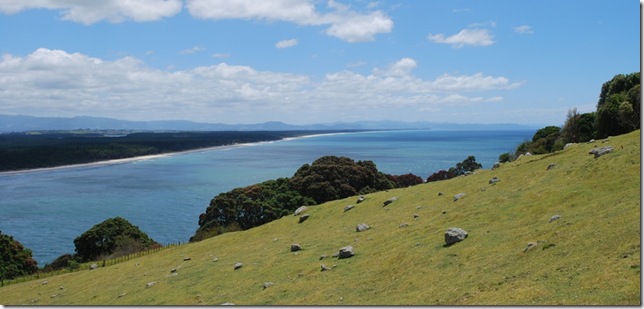 Looking north over the Bay of Plenty from the Mount hillside
Looking north over the Bay of Plenty from the Mount hillside
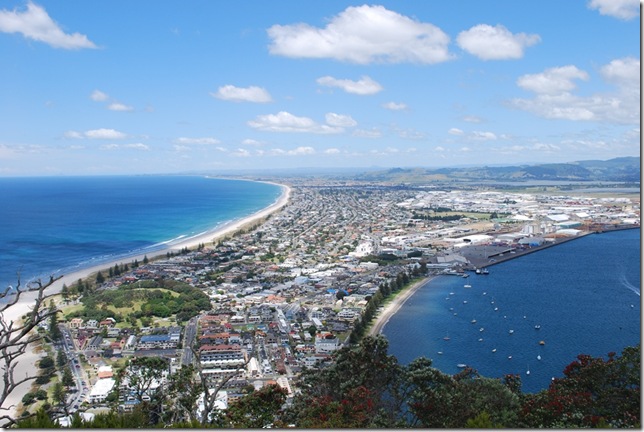 Looking back south over the tourist area and town of Mt. Maunganui
Looking back south over the tourist area and town of Mt. Maunganui
We still haven’t adjusted to first-world fashion prices, and life of the boat can be hard on clothes anyway, so we stopped off at the Red Cross thrift store on the way home from our hike and found some nice bargains. The store had a pretty funny sign in the window advertising newly-arrived Australian fashions. It’s definitely the only time I’ve seen a charity thrift store advertising their fashionable merchandise, and the clothing seemed about the same as in the US. When we checked out, I noticed that the cruise ship schedule for the year was posted behind the counter. I had to ask. It’s really hard to imagine people out on a cruise ship vacation getting excited about the Red Cross thrift store (“See, dear, right here on the map, the Red Cross thrift store is within walking distance of the where the ship is docking in Tauranga. Isn’t that great?”) It turns out that some of the vacationers do wander in but there is apparently quite a rush on cruise ship days from the Philipino crews who are either purchasing clothes for women and children back home or freezing in the cooler New Zealand climate and need something warm to wear.


